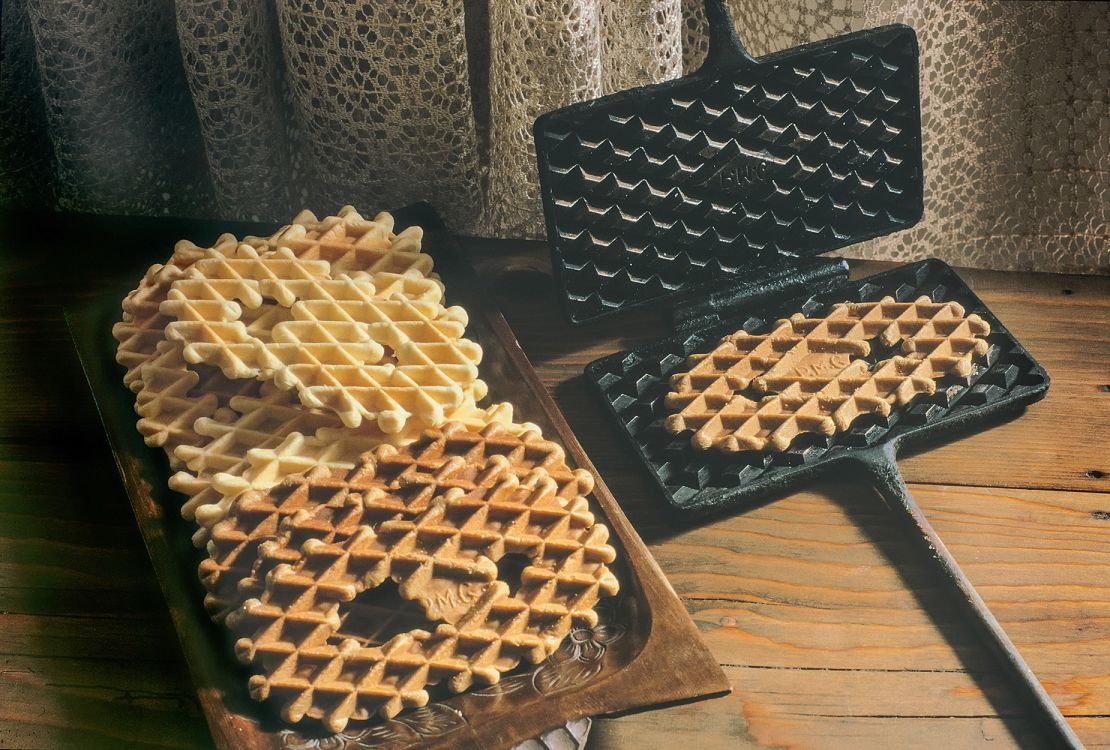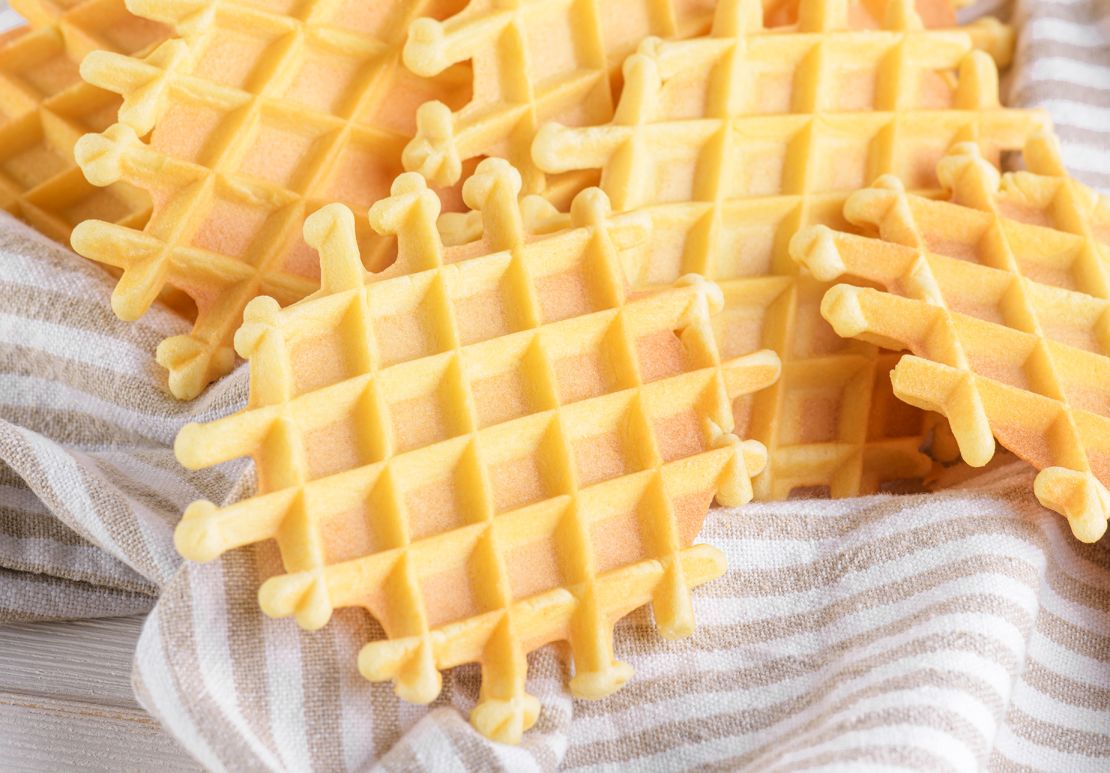Made from leavened batter or dough cooked between two patterned plates, waffles are thought to be one of the oldest desserts around.
Often topped with honey, whipped cream, syrup or jam, they’re ideal for breakfast, or a snack, sometimes savored on the run.
Hugely popular in northwestern European countries, as well as the US and Asia, they can be crispy, sweet or salty, with deep or shallow grooves.
In Belgium, where they’re known as gaufres, you can find infinite waffles variations.
Origin story

But where do they actually come from? Experts say the origins of this sweet or savory treat date back millennia.
And while their roots can be traced back to Ancient Greece, Giorgio Franchetti, author of the book “Dining With The Ancient Romans,” believes waffles are derived from a particular delicacy of Ancient Rome.
“They are very likely the descendants of the popular ‘crustulum’ (‘crustula’ plural,) which were sweet biscuits adored by the ancient Romans,” Franchetti, a food scholar of ancient Rome, tells CNN.
“The term, in Latin, clearly suggests that these biscuits were crispy, with a crumbly crust that melted in the mouth.”
There are no known historical documents on how crustula were shaped, but Franchetti believes they were likely flat biscuits, made with the same basic ingredients as waffles and baked inside two heated irons.
The preparation method for crustula is thought to be identical to that of modern-day waffles, although it’s unclear whether crustula originally had the iconic grooves.
According to research carried out by Franchetti, it’s likely that crustula were a sweet evolution of panis obelius, a special bread with olives or fresh figs made by the ancient Greek that was cooked between two irons and eaten during Dionysian rituals, which usually involved drinking, dancing and sacrifice.
“Crustula were very simple biscuits, made with flour, honey and lard. Today waffles are made with butter, however Roman philosopher Pliny the Elder writes that the use of butter differentiated the aristocratic, snobbish patricians from the commoner plebeians,” he says.
After unearthing texts on crustula by Pliny the Elder and Roman lyric poet Horace, Franchetti joined up with “archeo-cook” Cristina Conte to bring crustulas back from the grave.
Romans loved cheeses, but didn’t like butter, which was considered a poor byproduct of milk, and mainly used for cosmetics, according to Franchetti.
Instead, they made their crustula with lard or animal fat.
It’s thought that the biscuits were originally consumed during Roman religious ceremonies and sold by street vendors called “crustulari” who could be found along the alleys of ancient Rome, usually near temples and places of worship.
Franchetti explains that the coveted sweets later became a type of reward that teachers working for rich families would bestow on their best students.
Sweet evolution

In his Satires poems, Horace writes that teachers would usually give crustula “to children to convince them to learn the letters of the alphabet.”
Over time, these simple, tasty biscuits managed to conquer a very important part of the banquet ceremony – dessert – and were served at the end of a meal.
Crustula were so popular with ancient Roman writers that some even mentioned them in their works.
Satirist Gaius Lucilius, considered the inventor of Roman satire, once wrote that he “enjoyed indulging in crustula alone,” while other authors like playwright Plautus, and philosophers Seneca and Lucius Apuleius, also referenced them.
After the advent of Christianity, crustula were assimilated into Christian recipes, says Franchetti.
So how did these treats evolve into waffles as we know them today?
Franchetti believes that the crustula cooking technique was likely honed during the Middle Ages, when the first grooves may have appeared in the biscuits, bringing them closer to modern day waffles.
Ferratelle – a biscuit that has stood the test of time in various parts of Italy – is believed to be the link between Roman crustulas and waffles.
“In Molise and Abruzzo locals are weaned on ferratelle, that are eaten year-round and come in different shapes and sizes,” says Franchetti.
The name “ferratelle” comes from the metal press or iron, which translates to “ferri” in Italian, a tool that’s still used to make the biscuits in some places today.
Ferratelle, also known as pizzelle, feature the tiny square grooves found on waffles, while the basic recipe and ingredients are most likely the same as those previously used for crustula, says Franchetti.
In the old days, ferratelle were always homemade and proved to be particularly popular during Christmas and carnival celebrations.
Households would use special irons engraved with their family coat of arms or initials to mark their ferratelle.
“The Romans handed down to us these divine biscuits. We’ve been gulping them down since the dawn of ages,” says Maria Teresa Spagnoli of L’Aquila pastry shop Dolci Aveja.
In the 1700s, parents would gift ferratelle irons with the family’s initials to their soon-to-be-married daughters as part of the dowry.
“Today we eat them for breakfast, as an after dinner treat with a liquor digestive, or during car trips,” adds Spagnoli.
Still shaped inside irons, the Abruzzo ferratelle is made with eggs, olive oil, milk, vanilla and grated lemon peel.
Those sold in L’Aquila come in all different sizes, including diamonds, stars and hearts.
Treasured treats

Alongside the original recipe, Dolci Aveja, the top producer of ferratelle in L’Aquila, makes variants containing cereals and a salty version with rosemary, which pairs well with prosecco as an aperitif.
Preparing ferratelle is still a huge ritual for those who produce it.
“According to our tradition, to make perfect, authentic ferratelle you have to say one Hail Mary while cooking the first side, and one Lord’s Prayer for the other side,” says Spagnoli.
To speed up the cooking, locals in Abruzzo also use electric irons today.
With this method, there’s no need to turn the ferratelle over during the process, as it cooks simultaneously on both sides.
In Vasto, a coastal town in Abruzzo, ferratelle features dark chocolate toppings and are called “catarrette.”
Locals treasure the ancient irons used by their ancestors and engraved with their family initials.
Vasto historian Gianfranco Bonacci recalls how his grandmother would bake ferratelle on Sundays or special occasions, and the family would eat them throughout the week.
“It was a daily treat. Unfortunately my family has lost the old irons and today it’s hard to find a blacksmith who makes them, as there are very few blacksmiths left,” says Bonacci.
In nearby Italian regions, including Latium, there are ferratelle varieties with different names.
Waffle-like cookies can be found in Liguria, while in Piedmont, they’re known as gofri and come with a deep rough honeycomb pattern, reminiscent of Belgian gaufres.
So how and when did these “Italian waffles” migrate to north Europe and the US?
“The Romans, alongside their culture, also spread their foods throughout the empire. Crustula had many legs, and ended up all the way in nowadays France, Benelux and England,” says Franchetti.
By the time the Roman Empire collapsed, crustula had been assimilated into the local gastronomy of these lands.
A further development likely occurred along European trade routes during the Middle Ages, when the Italian honeycomb ferratelle were exported to northern Europe.
Finally, the leap over to the New World occurred in the early 1600s with the first Dutch settlers who landed in New York City.
“That’s when the crustula-ferratelle evolved into waffles and took root in America,” says Franchetti.
Today, waffles can be found almost everywhere in the world.
In the US, August 24, the anniversary of the day Dutch-American Cornelius Swarthout was granted a patent for the first waffle iron in the States, is celebrated as National Waffle Day.






